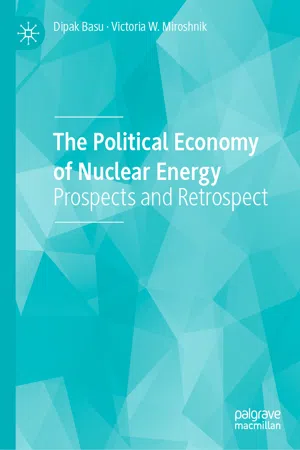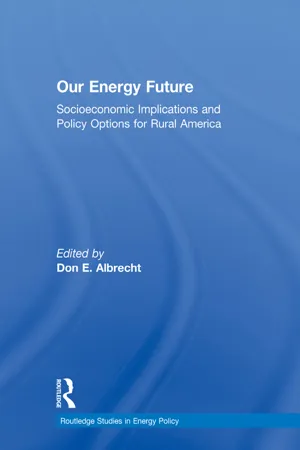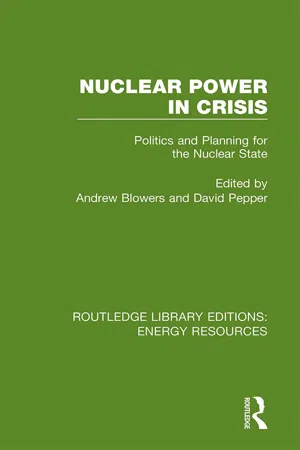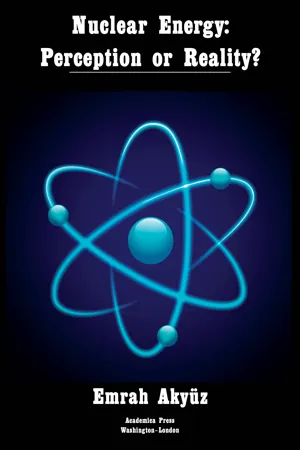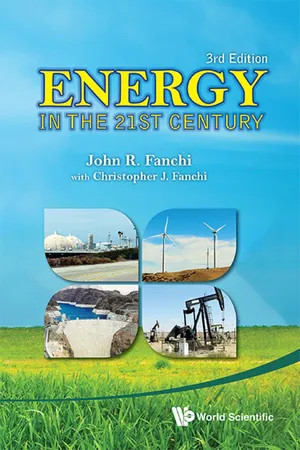Geography
Nuclear Power
Nuclear power is a form of energy generated by nuclear reactions, typically through the process of nuclear fission. It is a low-carbon energy source that can produce large amounts of electricity. However, it also raises concerns about nuclear accidents, radioactive waste disposal, and the potential for nuclear proliferation.
Written by Perlego with AI-assistance
Related key terms
Related key terms
1 of 4
Related key terms
1 of 3
5 Key excerpts on "Nuclear Power"
- eBook - ePub
The Political Economy of Nuclear Energy
Prospects and Retrospect
- Dipak Basu, Victoria W. Miroshnik(Authors)
- 2019(Publication Date)
- Palgrave Macmillan(Publisher)
Part I Political Economy of Nuclear PowerPassage contains an image
© The Author(s) 2019 D. Basu, V. W. Miroshnik The Political Economy of Nuclear Energy https://doi.org/10.1007/978-3-030-27029-2_2Begin Abstract2. Advantages of Nuclear Power
End AbstractDipak Basu1andVictoria W. Miroshnik 2(1) Reitaku University, Chiba, Japan(2) Nagasaki University, Nagasaki, JapanDipak BasuPeaceful Atom
The large-scale development of nuclear energy has been driven by the need for electricity as a result of rapid industrialization, exhaustion of energy reserves, and severe political instability in those countries exporting oil and gas. In addition, traditional energy supplies originating from fossil fuels harm the environment in terms of greenhouse gas emissions.Nuclear Power , the result of energy released during the fission of heavy nuclei and the fusion of light nuclei (at least in principle), has changed the landscape that existed in the first half of the twenty-first century. Expansion of the field of application of Nuclear Power is primarily determined by its economic implication. Oil was expected at the beginning of the century to be depleted in 20–30 years. This did not take place; by contrast, the scale of oil production has increased enormously. The same story will be repeated with uranium.Reducing the cost of nuclear electricity to make it sustainable will create new opportunities for electrical technology to be expanded. Since Nuclear Power - eBook - ePub
Our Energy Future
Socioeconomic Implications and Policy Options for Rural America
- Don Albrecht(Author)
- 2014(Publication Date)
- Routledge(Publisher)
1 as well as policy and technology decisions that have locked in the way that Nuclear Power is produced and managed. However, the greatest impediment to a nuclear renaissance may be the fundamental financial costs that slowed the industry to a virtual halt in the 1970s. This chapter examines the nuclear industry in the context of these technological, political, and financial factors and explores the potential risks and benefits of nuclear energy for rural communities. Currently, the impact on rural communities is relatively small. However unlikely, a nuclear renaissance would bring both potential benefits from the reduction of greenhouse gas emissions and increased risks if the problems of Nuclear Power are not dealt with effectively. The next section presents the historical background of Nuclear Power. Then the risks and benefits of Nuclear Power for rural communities are presented and discussed.BackgroundNuclear Power was not developed in response to a market need or entrepreneurial ingenuity. The first sustained nuclear reaction took place in 1942 in a squash court at the University of Chicago.2 The power of nuclear reactions was evident, and the United States military instituted a massive program to harness nuclear energy, first for destructive purposes through the development of nuclear bombs, and later through the development of Nuclear Power reactors. Initially, reactors were developed and used to power submarines. The adoption of these light water reactors for commercial purposes was both pragmatic and problematic. While it did allow for faster development and deployment of nuclear energy for commercial power generation, it also locked the industry into a particular design that was not necessarily optimal for land-based electrical power plants. Utilities quickly adopted nuclear technology, often in response to incentives from reactor manufacturers and overly optimistic forecasts of construction costs and energy demand. Thus, Nuclear Power was produced by technological, political, and financial willpower. This history significantly influences the potential implications for its continued use and future.There are 103 Nuclear Power plants currently operating in the United States. Approximately one third of these power plants are sited in rural jurisdictions (see Figure 5.1). Though many of the power plants in the United States were originally located in rural areas, substantial population increases in the past fifty years means that most are now located in suburban or urban areas. Since 2000 there has been an average increase of 10.9 percent in the population living within a five-mile radius of Nuclear Power plants, and a 27.4 percent increase in those living within a fifty-mile radius (Dedman 2011). Thus, any expectation that isolation from urban centers would provide some measure of protection to the population from any nuclear accident is no longer valid.3 - eBook - ePub
Nuclear Power in Crisis
Politics and Planning for the Nuclear State
- Andrew Blowers, David Pepper(Authors)
- 2019(Publication Date)
- Routledge(Publisher)
Transactions of the Institute of British Geographers , 54, 101–121.MANNERS, G. (1962) ‘Some location principles of thermal electricity generation’, Journal of Industrial Economics, 10, 218–230.MASON, P. E. (1971) ‘Some environmental considerations in the siting of Nuclear Power stations along the California coast’, Geography, 56, 335–337.MOUNFIELD, P. R. (1961) ‘The location of Nuclear Power stations in the United Kingdom’, Geography, 46, 139–155.MOUNFIELD, P. R. (1967) ‘Nuclear Power in the United Kingdom: a new phase’, Geography, 52, 310–316.OPENSHAW, S. (1980) ‘A geographic appraisal of nuclear reactor sites’. Area, 12, 287–290.OPENSHAW, S. (1982a) ‘The siting of Nuclear Power stations and public safety in the United Kingdom’, Regional Studies, 16, 183–198.OPENSHAW, S. (1982b) ‘The geography of reactor siting in the United Kingdom’, Transactions of the Institute of British Geographers (New Series), 7, 150–162.OPENSHAW, S. (1984) ‘An evaluation of the safety characteristics of current and future reactor sites’, The Statistician , 33, 133–142.TURVEY, R. (1963) ‘On investment choices in electricity generation’, Oxford Economic Papers , 15, 278–286.TURVEY, R. (1968) Optimal Pricing and Investment in Electricity Supply, London: George Allen and Unwin.Passage contains an image
Chapter Three
NUCLEAR ENERGY IN FRANCE: A FORETASTE OF THE FUTURE?Miriam J. Boyle and Mike E. Robinson
France is a powerful industrial nation with large energy demands but few indigenous resources. Since the oil crisis of 1973 successive governments have been committed to closing this gap through the development of a massive nuclear energy industry. In some ways they have been very successful, translating policies into projects with startling rapidity. They now lead the West in many areas of civilian nuclear technology and they are certainly the most vigorous prosecutors of reactor construction both at home and overseas. We begin this chapter, therefore, by a consideration of the circumstances of this progress. We outline the highly integrated administrative and industrial structure of nuclear energy production and we describe the expansion of the reactor programme and the steps that have been taken to strengthen French control over every other aspect of the fuel cycle. - eBook - ePub
Nuclear Energy
Perception or Reality?
- Emrah Akyüz(Author)
- 2022(Publication Date)
- Academica Press(Publisher)
2. NUCLEAR ENERGY
The term nuclear comes from the English word “nucleus.”289 The word “nucleus,” used in physics, means “the central part of an atom, usually composed of protons and neutrons,” according to the Cambridge Dictionary.290 The central part of the atom is also called the atomic nucleus. From this point of view, nuclear energy means atomic energy or atomic nucleus energy. In other words, nuclear energy is the energy source obtained from the atom. To put it more concretely, nuclear energy is the conversion of heat from the division of uranium by colliding with neutrons into energy.The main fuel used in Nuclear Power plants is uranium. Uranium, which was discovered by the German chemist Kloproth in 1789291 , can only be extracted from solid ores.292 Uranium, which is a radioactive element293 , is intensely found in saltwater sources. It is known that there are 4.5 billion tons of uranium in sea and ocean water.294 Natural uranium consists of two isotopes. The first of these is Uranium-238 (U238), which is the most abundant in nature. Since it is an indivisible isotope, it cannot be used in nuclear reactors.295 The second is Uranium-235 (U235). Today, Uranium-235 and enriched uranium are most commonly used in Nuclear Power plants.296 Until 2010, 2.5 million tons of uranium were mined. 2 million tons of this was used in electricity generation and the remaining 500 thousand tons were used for military purposes.297Nuclear energy emerges as a result of the nuclear fuel cycle. The nuclear fuel cycle is a long and complex process.298 This cycle consists of three stages. The first stage is the “initial stage.” The initial stage is the process of making the nuclear fuel ready. Some of the activities done in the beginning phase are as follows; mining, conversion, enrichment, and fuel production. The second stage covers the process of generating energy from nuclear fuel. There are two basic methods used in the fuel cycle.299 The first of these methods is the once-through cycle. In this method, the uranium used in Nuclear Power plants is stored as waste in storage facilities. The second method is the closed fuel cycle. In this method, the plutonium formed during energy production is separated from the spent fuel and reused as fuel. The third step in the fuel cycle is the back end. The last stage covers the activities carried out after the nuclear fuel is taken from the Nuclear Power plant. Some of them are as follows; nuclear waste storage, nuclear waste reprocessing, and nuclear waste disposal.300 - eBook - ePub
- John R Fanchi(Author)
- 2013(Publication Date)
- WSPC(Publisher)
Table 5-5 lists the top ten producers of electric power from nuclear energy and their percentage of the world’s total electric power generation from nuclear energy for the year 2009. The total electric power generated from nuclear energy in the world was 2,569 billion kilowatt-hours in 2009. Total electric power generated in the world that same year was 18,980 billion kilowatt-hours. Consequently, electric power generated from nuclear energy provided approximately 13.5% of the electric power generated in the world in 2009.Some of the nations that use nuclear energy to produce electricity also have nuclear weapons, but some of the nations do not. For example, the United States, Russia, and France have nuclear weapons while Japan and Germany do not. The decision to enrich uranium so that it can be used in a nuclear weapon depends on factors such as the history of the nation and its politics. The United States, for example, developed nuclear weapons in an effort to quickly end World War II. Japan and Germany, on the other hand, were defeated in World War II and their militaries were subject to restrictions imposed by the victors, notably the United States, Russia, Great Britain, France, and China.Some countries are highly dependent on nuclear energy. Table 5-6 shows the percentage of electric power generated from nuclear energy compared to total electric power generation for the top ten producers of electric power from nuclear energy for the year 2009. Nuclear energy was used to generate three quarters of the electric power generated in France. Ukraine uses Nuclear Power to generate approximately 48% of its electricity.Table 5-5Top Ten Producers of Electric Power from Nuclear Energy in 2009 [US EIA Nuclear, 2012] Table 5-6Dependence of Nations on Nuclear Energy in 2009 [US EIA Nuclear, 2012]5.4 NUCLEAR ENERGY AND THE ENVIRONMENTThe selection of an environmentally compatible primary fuel is not a trivial problem. Two energy sources of special concern for the 21st century energy mix are nuclear fission and nuclear fusion. We consider their environmental impact in more detail here.5.4.1 Nuclear FissionCompared to fossil fuel driven power plants, nuclear fission plants require a relatively small mass of resource to fuel the nuclear plant for an extended period of time. Nuclear fission plants rely on a nonrenewable resource: uranium-235. The earth’s inventory of uranium-235 will eventually be exhausted. Breeder reactors use the chain reaction that occurs in the reactor control rods to produce more fissionable material (specifically plutonium-239).
Index pages curate the most relevant extracts from our library of academic textbooks. They’ve been created using an in-house natural language model (NLM), each adding context and meaning to key research topics.
Explore more topic indexes
Explore more topic indexes
1 of 6
Explore more topic indexes
1 of 4
